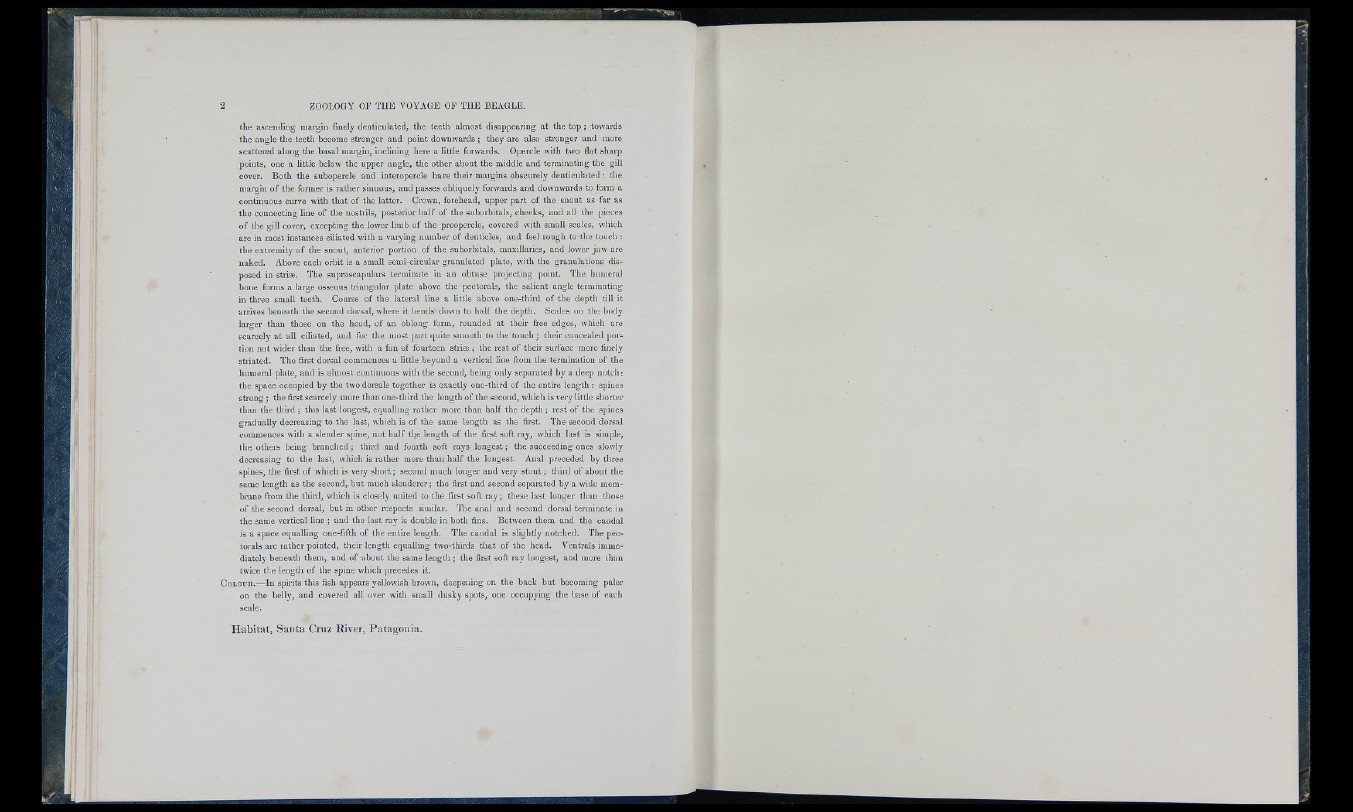
the ascending margin finely denticulated, the teeth almost disappearing at the to p ; towards
the angle the teeth become stronger and point dow nw ards; they are also stronger and more
scattered along the basal margin, inclining here a little forwards. Opercle with two flat sharp
points, one a little below the upper angle, the other about the middle and terminating the gill
cover. B oth the subopercle and interoperele have their margins obscurely d en ticulated: the
margin of the former is rather sinuous, and pa.sses obliquely forwards and downwards to form a
continuous curve with that of the latter. Crown, forehead, upper part of the snout as far as
the connecting line of the nostrils, posterior half of the suborbitals, cheeks, and all the pieces
of the gill cover, excepting the lower limb of the preopercle, covered with small scales, which
are in most instances ciliated with a varying num ber of denticles, and feel rough to the touch :
the extremity of the snout, anterior portion of the suborbitals, maxillaries, and lower jaw are
naked. Above each orbit is a small semi-circular granulated plate, with the granulations disposed
in striffi. The suprascapulai-s terminate in an obtuse projecting point. The humeral
bone forms a large osseous triangular plate above the pectorals, the salient angle terminating
in three small teeth. Course of the lateral line a little above one-third of the depth till it
arrives beneath the second dorsal, where it bends down to h alf the depth. Scales on the body
larger than those on the head, of an oblong form, rounded at their free edges, which are
scarcely a t all ciliated, and for the most part quite smooth to the to u ch ; their concealed portion
not wider than the free, with a fan o f fourteen stri® ; the rest of their surface more finely
striated. The first dorsal commences a little beyond a vertical line from the termination of the
hum eral plate, and is almost continuous with the second, being only separated by a deep notch:
the space occupied by the two dorsals together is exactly one-third of the entire length : spines
strong ; the first scarcely more than one-third the length of the second, which is very little shorter
than the third ; this last longest, equalling rather more than h alf the d ep th ; rest of the spines
gradually decreasing to the last, which is of the same length as the first. The second dorsal
commences with a slender spine, not half the length of the first soft ray, which last is simple,
the others being bran ched ; third and fourth soft rays lon gest; the succeeding ones slowly
decreasing to the last, which is rather more than half the longest. Anal preceded by three
spines, the first o f which is very short; second much longer and very sto u t; third of about the
same length as the second, but much slenderer; the first and second separated by a wide membrane
from the third, which is closely united to the first soft ra y ; these last longer than those
of the second dorsal, but in other respects similar. The anal and second dorsal terminate in
the same vertical line ; and the last ray is double in both fins. Between them and the caudal
is a space equalling one-fifth of the entire length. T he caudal is slightly notched. The pectorals
are rather pointed, their length equalling two-thirds that of the head. Ventrals immediately
beneath them, and of about the same len gth ; the first soft ray longest, and more than
twice t!:e length of the spine which precedes it.
C o l o u r .— In spirits this fish appears yellowish brown, deepening on the back but becoming paler
on the belly, and covered all over with small dusky spots, one occupying the base of each
H abitat, Santa Cruz River, Patagonia.